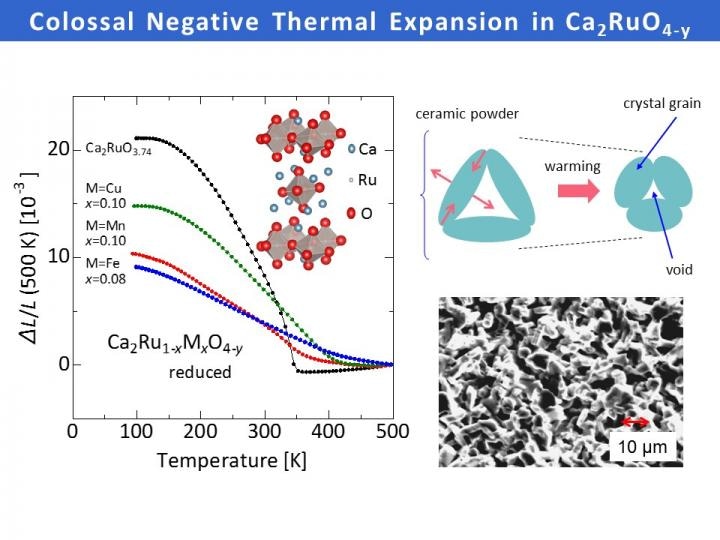Feb 9 2017
In today’s industry, machines and devices need to be able to endure harsh conditions. The volume of the materials used in these devices typically changes slightly, mostly by less than 0.01% when there is a change in the environmental temperature.
 A layered ruthenate Ca2RuO4-y ceramic body contracts on heating, or exhibits negative thermal expansion (NTE). The sintered-body structure shows colossal NTE when extremely anisotropic thermal expansion of the crystal grains produces deformation, consuming open spaces (voids) on heating. The total volume change related to NTE reaches 6.7 percent at most, the largest reported so far. (CREDIT - Koshi Takenaka)
A layered ruthenate Ca2RuO4-y ceramic body contracts on heating, or exhibits negative thermal expansion (NTE). The sintered-body structure shows colossal NTE when extremely anisotropic thermal expansion of the crystal grains produces deformation, consuming open spaces (voids) on heating. The total volume change related to NTE reaches 6.7 percent at most, the largest reported so far. (CREDIT - Koshi Takenaka)
Though this change looks insignificant, over time this thermal expansion may lead to the critical degradation of the operation of industrial systems and devices.
Industrial engineers are thus keen to work with negative thermal expansion materials or materials that contract on heating. These materials can be blended with regular materials, which expand on heating, with the final goal of creating a composite material with its thermal expansion modified to a specific value, mostly zero, and maintained even at the very low operating temperatures used in aerospace and cryogenic engineering.
A new research led by Nagoya University reports a reduced ruthenate ceramic material, composed of ruthenium, calcium, and oxygen atoms, which shrinks by 6.7% when heated. This is a record-breaking shrinkage, over twice the existing record for a negative thermal expansion material. Furthermore, when it is cooled, the bulk material expands again. The research details have been published in Nature Communications.
Industrial engineers now have a novel group of composite materials that can be used to boost the accuracy of measurements and processes, and to enhance the stability of device performance and prolong the service life of devices.
The operating temperatures for negative thermal expansion as well as the size of the volume change can be manipulated by modifying the material’s composition. When the ruthenium atoms are partially substituted by iron atoms, the temperature window for negative thermal expansion becomes a lot larger. In the case of the iron-containing material, this window extends to over 200 °C, which makes it especially promising for industrial application.
Observing that the volume changes were stimulated at the same temperature as the reduced ruthenate material changed from a metallic to a non-metallic state, the team studied the changes in the placement of the atoms using X-ray methods. They noticed remarkable changes upon heating, with the internal atomic structure expanding in certain directions but contracting in others.
Although the internal structure exhibited a net contraction, the crystallographic changes were not significant to explain the huge volume changes in the bulk material. Instead, the researchers focused their attention on the overall structure of the material, and discovered empty voids surrounding the ceramic grains.
The non-uniform changes in the atomic structure seem to deform the microstructure of the material, which means that the voids collapse and the material shrinks. This is a new way of achieving negative thermal expansion, and it will allow us to develop new materials to compensate for thermal expansion.
Koshi Takenak